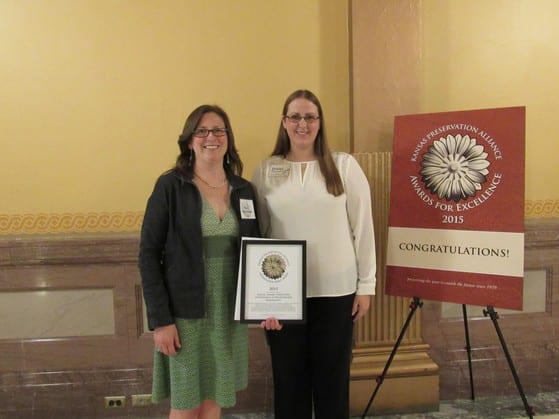| Year(s) Listed: • 2015 |
| City/Town: • Manhattan |
| Location Class: • Residential |
| Built: 1860 | Year Saved: N/A |
| Awards: • Merit Award |
| Contributor: Kansas Preservation Alliance |
The simple Kansas farmstead is a common sight across the state, and the Samuel Kimble Farmstead in Manhattan is an example typical to the Flint Hills. Samuel Kimble was an early pioneer in the Manhattan area, having moved from Ohio in 1857 to work as a carpenter and stonemason at Ft. Riley. In 1860, he moved his family from Ohio and began building the stone house and farm buildings on the farmstead west of Manhattan in 1860. The two story limestone house was constructed 1860-61, nestled against the hillside such that the hill helped to keep the house cool in summer and warm in winter. A two-story gabled addition also of stone was added to the west side of the original house in the1880s. In later years, the Kimble house fell into disrepair when the descendants who owned the farmstead moved from the area in the 1940s. The house was abandoned and left vacant for over 20 years. In the 1970s when Robert and Joan Page purchased the property, neighboring farmers were using the house to store hay and for sheltering piglets. The Pages cleaned up the house and did some rehabilitation work in order to make a comfortable home for their family. Mr. Page had been using one of the barns as a studio until a fire in 1990 destroyed it, leaving only the limestone shell. As part of the rehabilitation, the 1970s interior finishes and appliances were replaced with historically appropriate fixtures, including a freestanding hutch with sink for the kitchen cabinets and a custom-built refrigerator designed to look like an ice box. Non-historic carpet flooring was replaced with reclaimed wood, and the original second floor wood flooring was retained. As originally the house would not have had electric lighting, that which was installed was designed to be discreet, and in more visible locations period-appropriate fixtures were selected. Outside, the buried spring that originally ran through the front yard was uncovered, thousands of square feet of hand-stacked native stone retaining walls on the site were restored, and the shell of the burned barn was turned into an outdoor patio space.
The project team included: Go Katz Properties LLC, and Capstone 3D Development Group.

